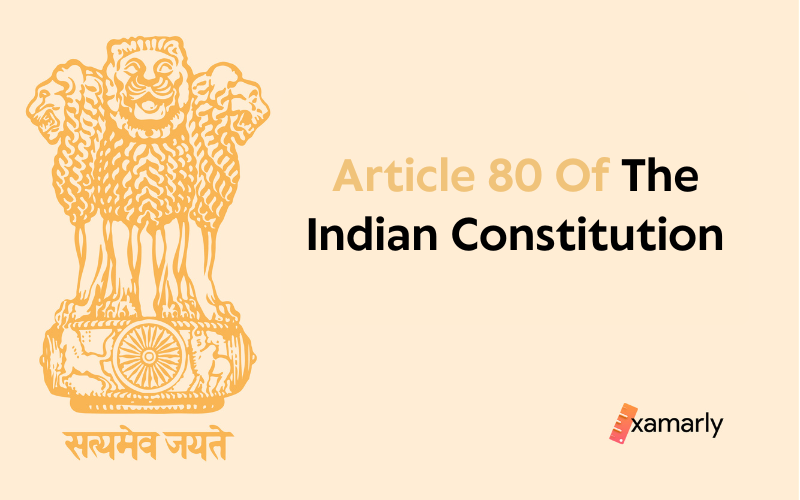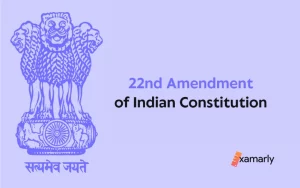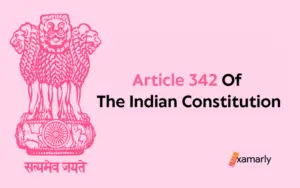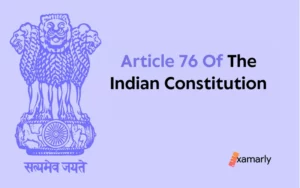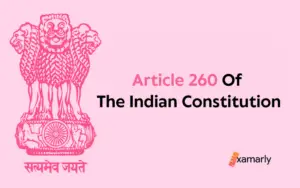Article 80 of the Indian Constitution outlines the composition of the Council of States. The President of India has the authority to nominate 12 Rajya Sabha members under Article 80. Additionally, it describes how many members there are and how these members are chosen.
This article is beneficial for the UPSC Exam preparation. This article belongs to the Indian Polity of UPSC CSE Syllabus. Read it further to figure out the provisions this Article of the Constitution contains.
What Is The Article 80 Of The Indian Constitution?
The composition of the Rajya Sabha is outlined in Article 80 of the Indian Constitution.
- Article 80 states that the Council of States should be composed of:
- (a) twelve members, who must be proposed by the President in line with the provisions of clause (3); and
- (b) no more than 238 delegates from the States and Union territories.
- The allotment of seats in the Council of States to be filled by representatives of the States and of the Union territories shall be in conformity with the Fourth Schedule’s regulations in that regard.
- The members who must be proposed by the President pursuant to clause (1), subclause (a), shall be composed of individuals with expertise or relevant experience in respect of art, literature, social service, and science.
- The elected members of the state’s Legislative Assembly, using a single transferable vote with the proportional representation method, elect the representatives of each State to the Council of States.
- The Parliament of India may by law specify the process for choosing the Union territories’ representatives in the Council of States.
Article 80 has been amended by the 7th, 35th, and 36th amendments of the Indian Constitution.
Candidates can get ready for the UPSC exam by reading the following articles about Indian politics:
Composition Of The Rajya Sabha
There can only be 250 members of the Rajya Sabha at a time, of whom 238 must be indirectly elected state and union territory MPs and 12 must be the president’s nominees.
The distribution of Rajya Sabha seats to the states and union territories is covered in the 4th Schedule of the Constitution.
Representation Of States
State legislative assemblies elect the individuals who represent each state in the Rajya Sabha.
By using a single transferable vote, the election is conducted in accordance with the proportional representation system.
According to population, the states are assigned seats in the Rajya Sabha.
As a result, there are different numbers of representatives in each state.
For instance, Tripura has just 1 member while Uttar Pradesh has 31.
Representation Of Union Territories
Members of an electoral college formed especially for the purpose of indirectly electing the representatives for each union territory in the Rajya Sabha.
The single transferable vote is used in this election as well, which is conducted in accordance with the proportional representation system.
Only three of the nine Union Territories—Delhi, Puducherry, and Jammu and Kashmir—have representatives in the Rajya Sabha.
There are no representatives in the Rajya Sabha from the remaining six Union Territories because of their small populations.
Nominated Members
Twelve members of the Second Chamber of the House of Parliament are chosen by the president from among candidates with special knowledge or practical experience in the fields of literature, science, the arts, or social service.
The purpose of this nomination rule is to provide renowned individuals a seat in the Upper House of Parliament without having to go through the electoral process.
Conclusion
Article 80 of the Indian Constitution contains in Chapter II of Part V of the Constitution. This article speaks about the Composition of the Upper House of the Bicameral Parliament.
FAQs
What Does It Mean When Someone Says “The Upper House”?
It means the second chamber of parliament where the members are appointed by the president.
How Many People Are In The Upper House?
There are currently 245 members in the Upper House. However, the Second Chamber of the Parliament can have a maximum of 250 members.
Is Chandigarh A Member Of The Rajya Sabha?
The Lower House (Lok Sabha), often known as the House of the People, has a member of parliament (MP) from Chandigarh, a Union Territory without a legislative assembly.
Which Amendments Of The Indian Constitution Amended Article 80?
The 7th amendment, 35th amendment, and 36th amendment of the constitution have amended Article 80 of the Constitution of India.
What Is Article 80 (2) Of The Indian Constitution?
The allocation of seats in the Council of States to be occupied by representatives of the States and of the Union territory shall be in accordance with the rules pertaining to that matter in the Fourth Schedule.


